Salt-free water softeners, also known as water conditioners, are the perfect solution for homes seeking to crystallize the calcium and magnesium minerals prevalent in hard water. As the name suggests, they don’t use any salt or chemicals to do this, which means they don’t leak any byproducts into the environment.
Our top choice non-salt water softener system for 2024 is the SpringWell FutureSoft FS1. It has a grain capacity of 81 GPG, which allows it to handle very hard water, and its high flow rate makes it suitable for small and large homes.
The more affordable option is the Aquasana Salt-Free Water Conditioner. This unit has a much lower grain capacity of 25 GPG but a similar flow rate, which prevents pressure drops after installation.
If you’re looking for salt-based solutions, see our article on top water softener systems.
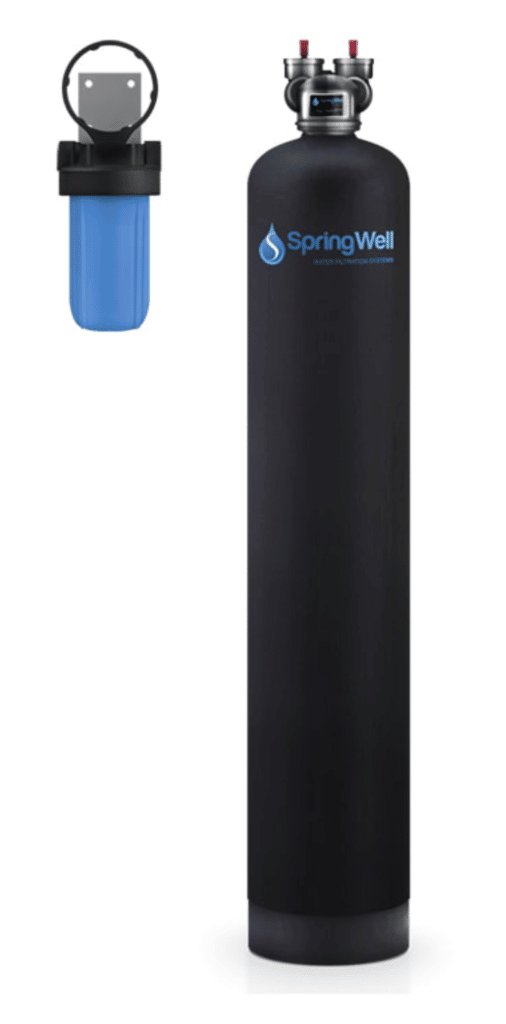
- Process: Template-Assisted Crystallization
- Grain Capacity: 81 GPG
- Flow Rate: 12 – 20 GPM
- Warranty: Lifetime Warranty on Valves and Tanks
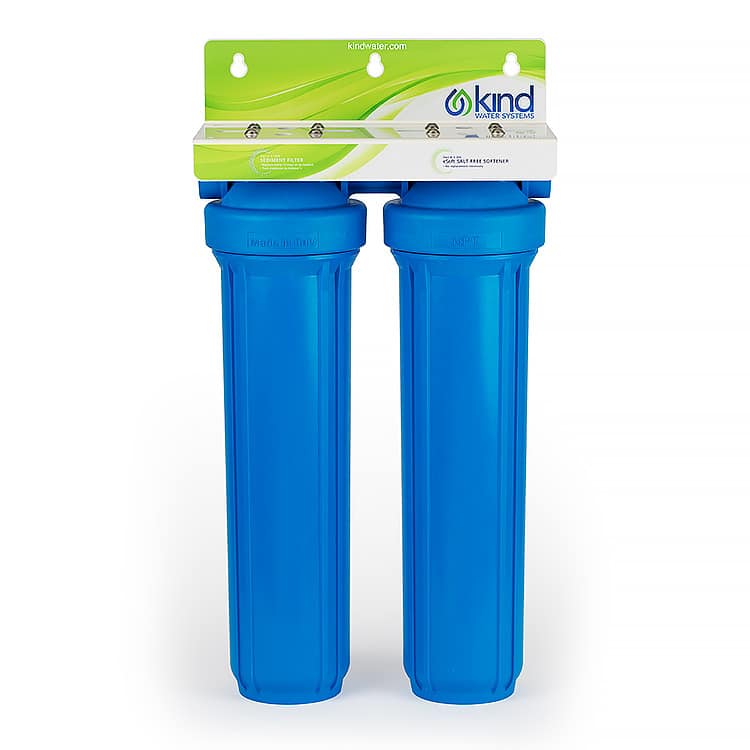
- Process: Template-Assisted Crystallization
- Grain Capacity: 75 GPG
- Flow Rate: 15 GPM
- Warranty: Lifetime
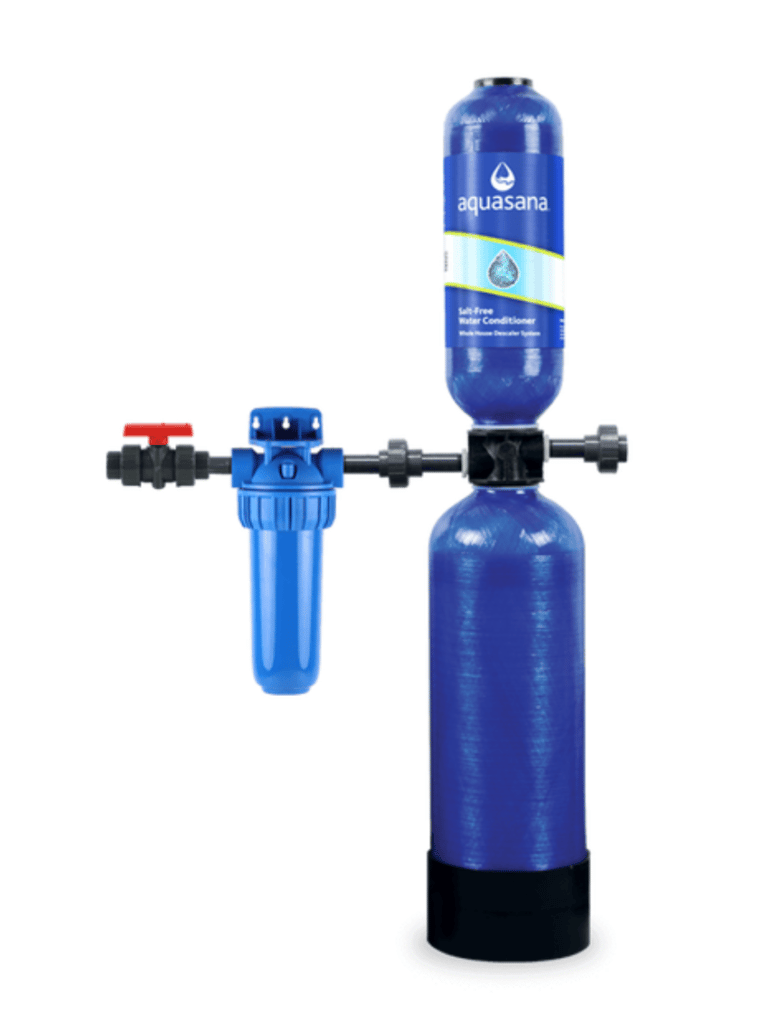
- Process: Template-Assisted Crystallization
- Grain Capacity: 25 GPG
- Flow Rate: 14 GPM
- Warranty: 6 yrs
1. Best Overall: Springwell FutureSoft FS1 Salt-Free Water Softener
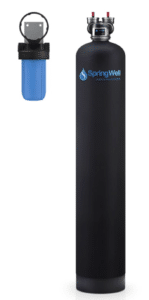
- Process: Template-Assisted Crystallization
- Grain Capacity: 81 GPG
- Flow Rate: 12 – 20 GPM
- Warranty: Lifetime Warranty on Valves and Tanks
- Price: $1,597
The SpringWell FutureSoft Salt-Free Water Softener is our top pick because it provides 95% scale prevention, wastes no water, and uses ActiveFlo Technology to soften water without any pressure drops.
We found it was the best option for moderately to very hard water. Plus, the fact it’s available in three sizes means it’s suitable for homes of almost any size.
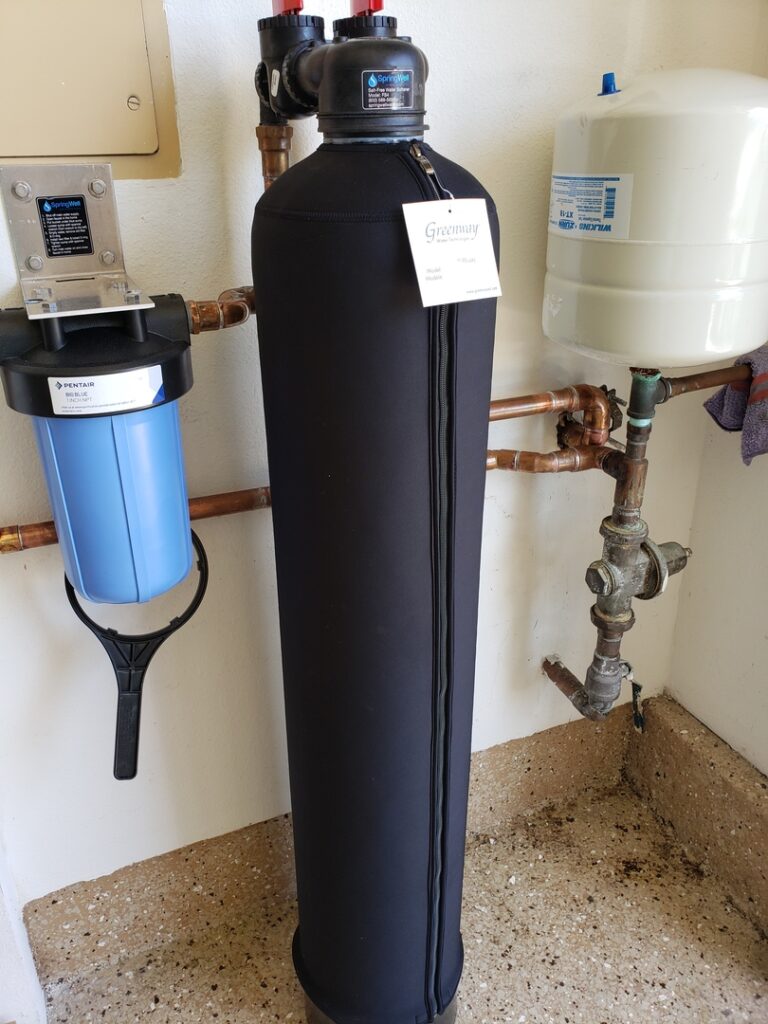
It Comes in 3 Sizes
The model itself comes in three different sizes. The smallest size is great for 1-3 bathrooms and costs $1,597.31. In terms of flow rate, it can deliver up to 12 GPM, which is more than enough for a single household. The medium-sized version of this model is ideal for larger households with 4-6 bathrooms, as it can output around 15 GPM and will set you back $1,960.44.
Finally, the large-sized version of this salt-free water softener model will cost you $2,657.64, but for that amount of money, you’ll get a high flow rate of 20 GPM. This sort of GPM output can provide softened water for 7 bathrooms or more, so it’s a bit of an overkill for a single household, but it would be a great fit for a small apartment building complex.
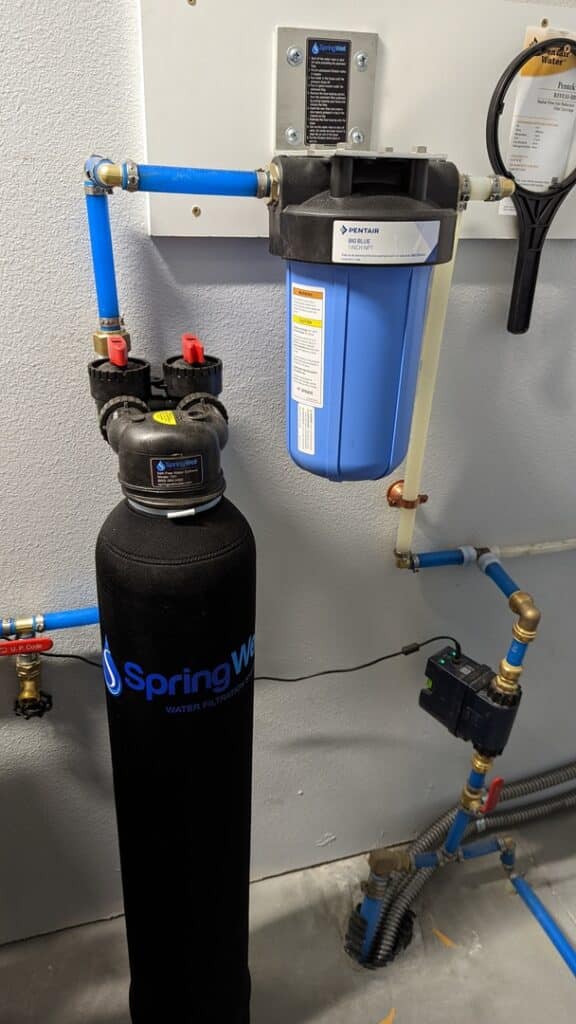
It Has Effective Crystallization Technology
If you have hard water, then you’ve probably experienced issues like scale buildup in your appliances and clothes that feel rough to the touch after they’ve been washed. We found the FS1 to be really effective at eliminating these issues due to its FutureSoft media, which converts the minerals in hard water into crystals. This stops them from sticking to surfaces and is why the FS1 prevents 95% of limescale buildup.
With some of the other softeners we tested, we noticed a significant decrease in water pressure once the system was installed. This wasn’t the case with the FS1. It uses ActivFlo Technology, which allows the system to operate at low and high flow rates without causing any pressure drops.
Optional Add-Ons
The SpringWell models also come with a few optional features if you want to upgrade the water softener device and turn it into a full-on water purification system that can get rid of a lot more contaminants. This is particularly helpful if your home is supplied with well water, as you’ll need to filter out contaminants like iron, chlorine, and lead before the water enters the softener.
You can get a UV purification add-on for $1,100.99, a whole-house water filter add-on for $1,737.21, and a reverse osmosis add-on for $457.83.
All of these upgrades add additional purification methods to your water system, so you don’t really need to buy them all, especially since they’re not exactly cheap. However, we would recommend testing your water and picking the purification method that can neutralize the specific type of contaminants found in your water.
Lifetime Warranty on Valves and Tanks
This water softener model also comes with a lifetime warranty on tanks and valves, as well as a 6-month money-back guarantee agreement. This means that any defective or damaged components can be replaced, and so can the whole device if it’s not working properly or you’re just not satisfied with its performance.
However, please keep in mind that SpringWell reserves the right to charge you a 25% restocking fee for all returned items, which is a policy put in place to stop people from taking advantage of the company and returning perfectly functioning models.
- GPG rating of 81, which makes it ideal for moderately to very hard water
- Incredibly high flow rates across the board
- The sediment pre-filter only needs to be changed every 6 months, saving you money on replacements
- Prevents 95% of scale formation, which increases the longevity of the system and your household appliances
- You wouldn’t need to hire a plumber to install it, especially if you buy the Easy Installation Kit for $157.49
- Wastes no water at all
- The upgrades double the price of the device
- This device isn’t NSF/ANSI certified
2. Runner-Up: Kind Water E-2000
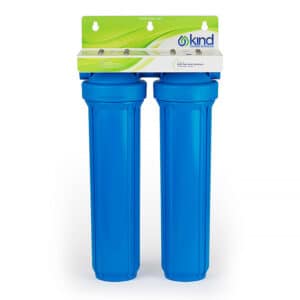
- Process: Template-Assisted Crystallization
- Grain Capacity: 75 GPG
- Flow Rate: 15 GPM
- Warranty: Lifetime
- Price: $1,048
Like the Springwell FS1, the Kind Water E-2000 also uses template-assisted crystallization to neutralize and prevent scale buildup. It has a high flow rate of 15 GPM, which means it’s suitable for both small and large homes, and it doesn’t cause pressure drops.
The dual-tank unit can be installed inside or outside your home and is designed to withstand temperatures between 36 to 120 degrees Fahrenheit. So, if you’re short on space inside your house, you can install it outside without worrying about it freezing.
It Has High Flow Rate and Minimal Pressure Drop
Due to its 15 GPM flow rate, we found that the E-2000 was just as effective in a home with three bathrooms as it was in one with six bathrooms. In the smaller home, there was no pressure drop at all—the faucets and showers were just as powerful as usual. In the larger home, we noticed a very slight drop in water pressure, but it was so minimal that it wasn’t an issue.
The only downside is that the E-2000 isn’t available in different sizes like the FS1, so 15 GPM is the maximum flow rate it can achieve. Still, this should be sufficient for most home sizes.
It is Easy to Install and Maintain
Unlike many other softeners we’ve evaluated, which had lots of different connections, the E-2000 only has two. So, we found it pretty easy to install without the help of a plumber. If you have no experience with plumbing, you might need to hire a plumber to assist with the installation, but it’s not an absolute necessity.
In terms of maintenance, it couldn’t be simpler. When it’s time to replace the filters, you just need to screw them off and then screw the new ones into place. We found that this took a matter of minutes, which was a relief after the complicated filter replacement for some other filters we’ve used.
- The filters are really easy to replace as you can simply unscrew the old ones and screw on new ones.
- The system only has two connections, making installation straightforward
- It has a high flow rate, which means it’s suitable for homes with up to six bathrooms
- We didn’t experience any pressure drops once the system was installed
- Like the FS1, it doesn’t waste any water
- It has a lower GPG rating (75) than the FS1, which means it doesn’t deal with very hard water as well as our top-rated model
3. Best Budget: Aquasana Rhino Water Conditioner
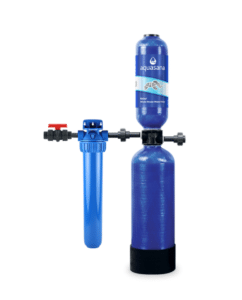
- Process: Template-Assisted Crystallization
- Grain Capacity: 25 GPG
- Flow Rate: 14 GPM
- Warranty: 6 yrs
- Price: $799
The Aquasana is without a doubt the most budget-friendly salt-free water softener on the market with a full-size tank, as it’ll only cost you $799 through the affirm payment method if you’re paying for it in one go.
Despite its low price, we found the system to be just as good in many areas as units with much higher price tags. In particular, the flow rate of 14 GPM was really impressive for such an affordable system, and during our evaluation, it comfortably handled large homes with multiple bathrooms.
Here are some of the features we liked the most:
- Different payment options: You have the option to go for the 3-month payment plan, which will cost you $819.05. You can also choose the 6-month plan, which will set you back $834.30, or the 12-month plan, which comes to a total of $865.36. Keep in mind that the price doubles if you’re not using the affirm payment method and becomes $1,598. However, there’s really no reason not to use the suggested payment option since it saves you quite a bit of money.
- Easy installation: Aside from the awesome price, these models are very easy to install. The fact that there aren’t any drain lines or backflushing channels that need to be connected makes them much more practical than standard water softeners. When installing, just don’t forget to turn off the main water valve before you get started, or you might make a mess that you’ll need to clean up later.
- High durability: The tank is made out of an HDTE (High Density, Tri-Extruded) material, which makes it durable while giving it a lightweight lining that makes moving the device a bit easier. Additionally, while it can still be damaged, the durable material means that the tank won’t crack so easily if it’s accidentally dropped or hit.
- Compact size: Coming in at a height of 46 inches and a length of 27 inches, the Aquasana isn’t as large as some of the other salt-free water softeners. This means that you can easily find a place for it even if your home is pretty cramped.
- Simple maintenance: In terms of maintenance, all you really need to do is get some pre-filter replacements and change them out every 2 months or so. The filter is easy to detach and replace, and while it still requires you to be handy with a wrench, you should get the hang of the process after doing it a few times. The frequency will depend on the amount of water that you use, but a triple pack is only $20, so it doesn’t cost much to maintain the water softener.
- The most affordable salt-free water softener on the market
- The dual-tank system means increased water contact time with the media, which leads to increased scale prevention
- The warranty covers the estimated lifespan of the device
- The high flow rate makes it suitable for larger homes, and we didn’t experience any pressure drops
- No drain lines, electricity, or backflushing required, making it incredibly easy to maintain
- The company recommends replacing the device every 6 years. So, although the initial cost is lower than the other units on our list, you may have to pay for a whole new system within a relatively short space of time
- It has a low GPG rating of 25
4. Best Descaler: Yarna Capacitive
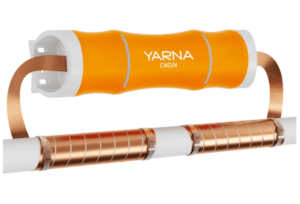
- Process: Electric impulses
- Grain Capacity: Unlimited
- Flow Rate: Unlimited
- Warranty: 1 year
While it’s referred to as a descaler, the Yarna Capacitive is still considered a water softener because it prevents the buildup of limescale.
This device is attached directly to the main water pipe in the house, and it releases electrical impulses that essentially break down the hard mineral molecules in the pipe. This is how it prevents hard molecules from sticking to the inside wall of the pipe or the faucet.
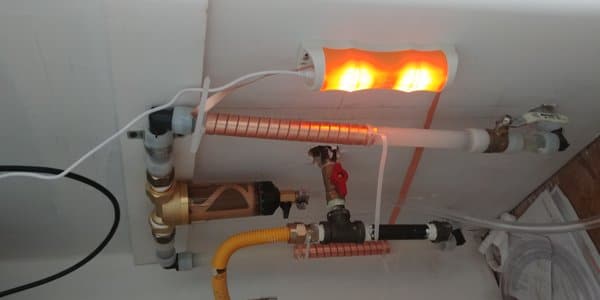
Here are some of the features we liked the most:
- Easy to install: The Yarna Capacitive can easily be installed in your home, even if you don’t know which side of a screwdriver to hold. You can find all of the instructions on the brand’s website, and the devices come with detailed user manuals that make the entire process quite straightforward.
- Very affordable: While the device only has a 1-year warranty, the $259.99 price tag means that you can pretty much afford to replace it twice in that same year and still not even pay as much as you would for the second cheapest water conditioner on our list (the Aquasana). In fairness, the Aquasana is a full-sized water softener; while this is just a descaler, but the Yarna still more than gets the job done for the price range that it sits in.
- Corrosion resistant: The Yarna Capacitive is made out of ABS plastic, which is resistant to chemical corrosion and pretty durable.
- Versatility: It’s also compatible with any and all types of pipe. The company’s site states that the unit is effective up to 1.2 miles from the installation point along your pipe system. This means that this single small device can be put on your main water pipe and can work its magic throughout your entire house.
- Incredibly simple to install
- Requires no maintenance whatsoever
- Very affordable
- The descaling process ends almost immediately after the water leaves the pipes, which means this unit isn’t nearly as effective as the other full softener systems on our list
How Do Salt-Free Water Softeners Work?
Standard water softeners use a process called ion exchange to replace the calcium and magnesium molecules with sodium molecules. This is done by funneling the water through a tank full of sodium-charged resin and then funneling the softened water without the hard minerals back into the pipes.
On the other hand, Salt-free water softeners work by using a process called Template-Assisted Crystallization, which we’ll just abbreviate as TAC from now on. TAC works by passing hard water through a special resin that changes the minerals from their base ionic forms into crystalline forms. In essence, this crystalline form allows the calcium and magnesium molecules to pass through pipes and other surfaces without bonding to them and creating limescale.
Water descalers like Yarna Capacitive are also considered water conditioners, but they work by emitting an electrical impulse through the water that prevents the minerals in the water from bonding to the inside of the pipes and forming limescale.
In essence, salt-free water softeners prevent the formation of limescale and other negative effects of hard water on your pipes and faucets without making the water taste salty or removing the beneficial minerals found in it.
What are the Disadvantages of No-Salt Water Softeners?
The biggest disadvantage of salt-free water softeners is that they don’t actually remove the hard water minerals; they only stop them from bonding to surfaces for a certain amount of time.
The crystallization eventually fades, which means that any body of water that’s left in a glass or a sink for too long will form limescale.
If we’re talking about dishes or glasses, then the water will need to stay on them overnight for limescale to form. You should be fine if you rinse them, then dry them right after that. Drying the sink or the bathtub with a towel is a bit more of a pain, but it’s still a pretty easy method to prevent the buildup of limescale on these surfaces.
Unfortunately, appliances like washing machines, dishwashers, and water heaters will still be affected by the hard water minerals since the water will sit for extended amounts of time in them.
What to Know Before Shopping
Here are the must-know water softener terminologies to aid your decision making:
- Grain capacity
- Water pressure/flow rate
- NSF certifications
- Process/technology
- Ease of installation
- Maintenance requirements
- Warranty
Grain Capacity
The grain capacity of a water softener determines what sort of hardness a particular model can handle. Simply put, the higher the grain capacity, the more grams of hard molecules per gallon (GPG) of water the device can soften.
| Water Softeners | Grain Capacity |
|---|---|
| SpringWell FutureSoft Salt-free Water Softener | 81 GPG |
| Kind Water E-2000 | 75 GPG |
| Aquasana Salt-Free Conditioner | 25 GPG |
| Yarna Capacitive | Unlimited |
Flow Rate
Flow rates determine what household size a particular water softener is ideal for. Single-digit flow rates usually mean that the device can only manage up to three bathrooms, flow rates of up to 15 GPM are suitable for households with 5 or 6 bathrooms, and anything above that is meant for either very large households or apartment complexes.
| Water Softeners | Flow Rate (GPM) |
|---|---|
| SpringWell Salt-free Water Softener | 12 – 20 |
| Kind Water E-2000 | 15 |
| Aquasana Salt-Free Conditioner | 14 |
| Yarna Capacitive | Unlimited |
NSF Certifications
The way a water conditioner gets an NSF certification is by being able to reduce the hardness of the water down to 1 GPG. This is a pretty stringent requirement, so a lot of models don’t actually qualify.
However, just because they don’t have this certification doesn’t mean that they’re any less useful at preventing scale buildup.
| Water Softeners | NSF/ANSI 44 Certifications |
|---|---|
| SpringWell Salt-free Water Softener | No |
| Kind Water E-2000 | No |
| Aquasana Salt-Free Conditioner | No |
| Yarna Capacitive | No |
Process
Most salt-free water softeners work by using the template-assisted crystallization process. However, there are also units like the Yerna descaler that use electric impulses that break apart the mineral clumps in the water into finer particles so that they don’t stick to the inside of the pipe so easily.
| Water Softeners | Process |
|---|---|
| SpringWell Salt-free Water Softener | Template-assisted crystallization |
| Kind Water E-2000 | Template-assisted crystallization |
| Aquasana Salt-Free Conditioner | Template-assisted crystallization |
| Yarna Capacitive | Electric impulses |
Ease of Installation
The truth is that most water softeners are difficult to install. First, there are a lot of components that need to be put together. Then the device itself needs to be fitted on the main water pipe of the house. If you’re not careful, you can either damage the softener and void the warranty or do some water damage to the house.
However, there are also a few models that are pretty simple to attach and won’t take more than an hour or so to install.
| Water Softeners | Ease of Installation |
|---|---|
| SpringWell Salt-free Water Softener | Moderate |
| Kind Water E-2000 | Easy |
| Aquasana Salt-Free Conditioner | Moderate |
| Yarna Capacitive | Easy |
Maintenance Requirements
The aim of water conditioners is to get rid of the need to keep filling the brine tank back up with salt and reduce the maintenance requirements in general. So it should be no surprise that the highest level of required maintenance involves replacing the pre-filters every 2 months or so.
The Springwell Filter & Softener Combo is the only device that’s the exception to the rule, but in fairness, that’s primarily due to the second tank that’s meant to deal with well water.
| Water Softeners | Maintenance Requirements |
|---|---|
| SpringWell Salt-free Water Softener | Moderate |
| Kind Water E-2000 | Minimal |
| Aquasana Salt-Free Conditioner | Minimal |
| Yarna Capacitive | None |
Warranty
Water softeners are appliances, so they have the same general warranty length as most other large appliances. The smaller and the less expensive models either won’t have a warranty or they’ll have one that lasts for a single year. The middle-of-the-road models usually have one that lasts for around 5-10 years, and the most expensive models typically have a lifetime warranty on the most important components.
| Water Softeners | Warranty |
|---|---|
| SpringWell Salt-free Water Softener | Lifetime warranty on tanks and valves |
| Kind Water E-2000 | Lifetime warranty on tanks and valves |
| Aquasana Salt-Free Conditioner | 6 years |
| Yarna Capacitive | 1 year |
Pre-Purchase Questions
- What is the Average Price of a Salt-Free Water Softener System?: Water descalers typically costs $200 – $500, whereas most salt-free water softener systems start at around $1,000, or $1,200, and can go as high as $4,000. There are two main reasons for the large price fluctuation in the full-sized models. The first reason is that certain brands simply cost more. SpringWell is a well-known name in the water filtration industry, and most people are willing to spend a few hundred more dollars if it means that they’re getting a reliable brand that’s been around for a while. The second reason for the price difference is the size and purpose of the softener. For example, the Aquasana is a smaller model that has a 25 GPG capacity, whereas the SpringWell FS1 is a massive unit with two tanks that has a grain capacity of up to 81 GPG.
- What Does Salt-Free Water Softener Installation Require?: Apart from the unit itself, the items needed for installation include:
Two 1-inch MNPT fittings
A bypass valve
A gasket
A tube
An O-ring
A hose bib assembly
A mounting bracket
Pre-filter housing
A spanner wrench
The above items are considered basic, and most water softeners come with them, so you should have gotten all of these items when you bought the appliance. The only exception is the spanner wrench, which you’ll need to get yourself. There’s also the sediment filter and the tank itself. Keep in mind that not all salt-free water softeners are the same. Some might have the sediment filter attached to the tank, so you might get fewer components than the ones we listed. The instructions are usually pretty clear about what needs to be attached and where, so you should be fine if you have all of the items listed and if you follow the instructions to the letter. - How Long Do Salt-Free Water Softeners Last?: In general, you should be able to get at least 10 good years out of your salt-free water softener if you maintain it properly and 15 if you’re lucky. This doesn’t include any unforeseen damages or extenuating circumstances that might cause damage to the softener. Additionally, while the water softener itself might last for a decade and a half, the same cannot be said for the resin inside the tank. The salt-free models don’t have salt tanks that need to be refilled constantly, but their resin needs to be replaced occasionally. While this depends on how much water you use on a regular basis, you shouldn’t need to replace the resin in the tank more frequently than every 2-3 years or so.
Final Verdict: Which One Should You Buy?
Salt-free water softeners come in many different shapes and sizes, but all of them can be useful in different circumstances.
SpringWell water softeners might be pricey, but the company is a reliable name in the field, so you know that you’ll be buying a quality product that’ll last you for a very long time.
The Kind Water E-2000 is an excellent option for larger homes with fairly hard water. The Yarna is an easy-to-install descaler for anyone who just wants to prevent limescale from forming in the pipes or around the faucets.
The Aquasana is the most cost-effective full-sized water conditioner, and it’s ideal for smaller homes where the flow rate isn’t all that important.